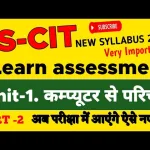RSCIT (Rajasthan State Certificate in Information Technology) is a computer literacy exam designed to enhance digital skills. Preparing for RSCIT requires understanding its syllabus and practicing various types of questions. This guide provides a comprehensive set of questions and answers to help you excel in the exam, covering all essential topics.
Computer Fundamentals
Question: What is a computer?
Answer: A computer is an electronic device that processes data to produce meaningful information.
Question: Name the primary components of a computer.
Answer: The primary components are the CPU, memory, input devices, and output devices.
Question: What is an operating system?
Answer: An operating system is software that manages hardware and software resources and provides common services for computer programs.
Question: Define RAM and ROM.
Answer: RAM is volatile memory used for temporary data storage, while ROM is non-volatile memory that stores permanent instructions.
Question: What is the function of the CPU?
Answer: The CPU executes instructions and processes data.
Question: What are input devices?
Answer: Input devices are hardware used to enter data into a computer, like a keyboard or mouse.
Question: What are output devices?
Answer: Output devices display or project data from a computer, such as monitors and printers.
Question: Define software.
Answer: Software is a collection of programs and instructions that run on a computer.
Question: What is the use of a hard disk?
Answer: A hard disk is used for long-term data storage.
Question: What is a network?
Answer: A network connects multiple computers to share resources and information.
Question: Explain the term “data processing.”
Answer: Data processing involves collecting, organizing, and analyzing data to generate useful information.
Question: What is an antivirus program?
Answer: Antivirus software detects and removes malware from a computer.
Question: What is cloud computing?
Answer: Cloud computing provides data storage and computing services over the internet.
Question: Define the Internet.
Answer: The Internet is a global network connecting millions of private, public, academic, business, and government networks.
Question: What is the full form of URL?
Answer: URL stands for Uniform Resource Locator.
Question: What is a file?
Answer: A file is a collection of data or information stored on a computer.
Question: What is a folder?
Answer: A folder is a virtual container for organizing files on a computer.
Question: What is a binary number?
Answer: A binary number consists of only two digits, 0 and 1, used in computing.
Question: What is an IP address?
Answer: An IP address is a unique numerical label assigned to devices on a network.
Internet and Digital Awareness
Question: What is email?
Answer: Email is an electronic method of exchanging messages over the internet.
Question: Define social media.
Answer: Social media refers to platforms that allow users to share content and interact online.
Question: What is e-governance?
Answer: E-governance uses technology to provide government services digitally.
Question: What is the use of a search engine?
Answer: A search engine helps users find information on the internet.
Question: Name some popular search engines.
Answer: Google, Bing, Yahoo, and DuckDuckGo.
Question: What is a blog?
Answer: A blog is a regularly updated website or web page, typically run by an individual or small group.
Question: What is phishing?
Answer: Phishing is a fraudulent attempt to obtain sensitive information, often via email.
Question: What is a digital signature?
Answer: A digital signature is a secure way to verify the authenticity of digital documents.
Question: Define e-commerce.
Answer: E-commerce is buying and selling goods or services online.
Question: What is an online payment gateway?
Answer: It is a service that processes online payment transactions.
Question: What is online banking?
Answer: Online banking allows customers to conduct financial transactions through the internet.
Question: What is cybersecurity?
Answer: Cybersecurity protects systems, networks, and programs from digital attacks.
Question: Define malware.
Answer: Malware is software designed to harm, disrupt, or gain unauthorized access to a system.
Question: What is a QR code?
Answer: A QR code is a matrix barcode used to store information readable by a machine.
Question: What is a domain name?
Answer: A domain name is the web address of a website, such as www.example.com.
Question: Define cloud storage.
Answer: Cloud storage stores data on remote servers accessed via the internet.
Question: What is net banking?
Answer: Net banking allows users to manage their bank accounts online.
Question: What is the purpose of encryption?
Answer: Encryption secures data by converting it into unreadable code.
Question: What is GPS?
Answer: GPS, or Global Positioning System, provides location and time information.
Question: What is the use of a router?
Answer: A router connects multiple devices to a network and directs data traffic.
RSCIT preparation requires regular practice of diverse questions from all subjects. By covering key topics and their solutions, this guide aims to strengthen your understanding and help you succeed in the exam. Regular revision of these questions will ensure you are well-prepared.
Latest Posts
- Step-by-step guide to download and apply for jee mains admit card 202
- Comprehensive 2025 government holidays and recruitment details for job seekers
- JEE Mains Admit Card 2025: Your Step-by-Step Guide to Downloading the Hall Ticket
- Everything You Need to Know About 2025 Government Holidays Recruitment
- Comprehensive Guide to rrb d group recruitment 2025 – Eligibility, Vacancies, and Application
- Detailed guide to nps trust recruitment 2025 vacancies, eligibility and apply process
- Comprehensive guide to hpcl recruitment 2025 notification, vacancies, and application process
- ignou bed admission 2025 complete recruitment guide with eligibility and process
- Comprehensive Guide to Indian Army Agniveer Recruitment 2025 Notification and Jobs
- Everything You Must Know About CBSE Board Exams 2025 Changes & New Rules



